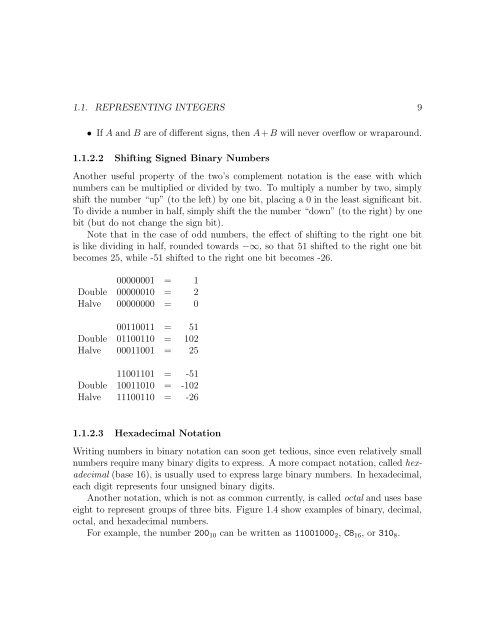MIPS Assembly Language Programming
MIPS Assembly Language Programming
MIPS Assembly Language Programming
Create successful ePaper yourself
Turn your PDF publications into a flip-book with our unique Google optimized e-Paper software.
1.1. REPRESENTING INTEGERS 9<br />
• If A and B are of different signs, then A + B will never overflow or wraparound.<br />
1.1.2.2 Shifting Signed Binary Numbers<br />
Another useful property of the two’s complement notation is the ease with which<br />
numbers can be multiplied or divided by two. To multiply a number by two, simply<br />
shift the number “up” (to the left) by one bit, placing a 0 in the least significant bit.<br />
To divide a number in half, simply shift the the number “down” (to the right) by one<br />
bit (but do not change the sign bit).<br />
Note that in the case of odd numbers, the effect of shifting to the right one bit<br />
is like dividing in half, rounded towards −∞, so that 51 shifted to the right one bit<br />
becomes 25, while -51 shifted to the right one bit becomes -26.<br />
00000001 = 1<br />
Double 00000010 = 2<br />
Halve 00000000 = 0<br />
00110011 = 51<br />
Double 01100110 = 102<br />
Halve 00011001 = 25<br />
11001101 = -51<br />
Double 10011010 = -102<br />
Halve 11100110 = -26<br />
1.1.2.3 Hexadecimal Notation<br />
Writing numbers in binary notation can soon get tedious, since even relatively small<br />
numbers require many binary digits to express. A more compact notation, called hexadecimal<br />
(base 16), is usually used to express large binary numbers. In hexadecimal,<br />
each digit represents four unsigned binary digits.<br />
Another notation, which is not as common currently, is called octal and uses base<br />
eight to represent groups of three bits. Figure 1.4 show examples of binary, decimal,<br />
octal, and hexadecimal numbers.<br />
For example, the number 20010 can be written as 110010002, C816, or 3108.

















